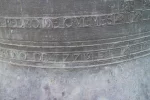scruffy1
Veteran Member
- Time of past OR future Camino
- Holy Year from Pamplona 2010, SJPP 2011, Lisbon 2012, Le Puy 2013, Vezelay (partial watch this space!) 2014; 2015 Toulouse-Puenta la Reina (Arles)
As the Muslims conquered Spain one of their first actions was to build a mosque in they settlements they conquered and settled. The Christians replied by loudly ringing the church bells whenever the muezzin called the Muslims to prayer. The significance of the bells should not be ignored since they called the faithful to prayer, marked great happiness and tolled at the death, today they also tell the time. In 997 al-Mansur’s raid on Santiago de Compostelo destroyed the church, burning the entire city to the ground. Evidence of the intensity of the defeat can be gathered from current excavations that reveal a layer of ash and rubble beneath the site of the cathedrals constructed by Alphonso II and III . The only portions of the city not left to burn were the shrine of Saint James and the cathedral bells which were taken booty and carried on the backs of Christian slaves to the Muslim hub city of Cordoba. In Cordoba, the bells were hung from the ceiling of the Great Mosque and used as oil lamps. Over 200 years after the bells were captured from Compostela by al-Mansur and his armies, on June 29, 1236, Christian King Ferdinand III of Castile and Leon recaptured the bells from the Great Mosque at Cordoba and returned them to the cathedral at Santiago de Compostela. They were not hung to ring again but simply displayed in a courtyard as a spoil of war and symbol of triumph. Now I have not visited the museum in Santiago for years and years and cannot recall seeing them there. , Were the mosque lamps reformed into bells? Did they remain as lamps? Where are they today?





















